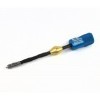Grumulkin
Member
One thing I think is pretty funny. It is common for there to be dyed-in-the-wool flash hole deburrers even with no demonstrable benefit. Contrast that with the question of "do eccentric flash holes make any difference?" Ask the latter questions and the majority will confidently declare that eccentric flash holes make no difference even though they've never tested the hypothesis.
I have been saving cases with eccentric flash holes and maybe some day I'll do the test. In the mean time, I don't load them.
I have been saving cases with eccentric flash holes and maybe some day I'll do the test. In the mean time, I don't load them.








